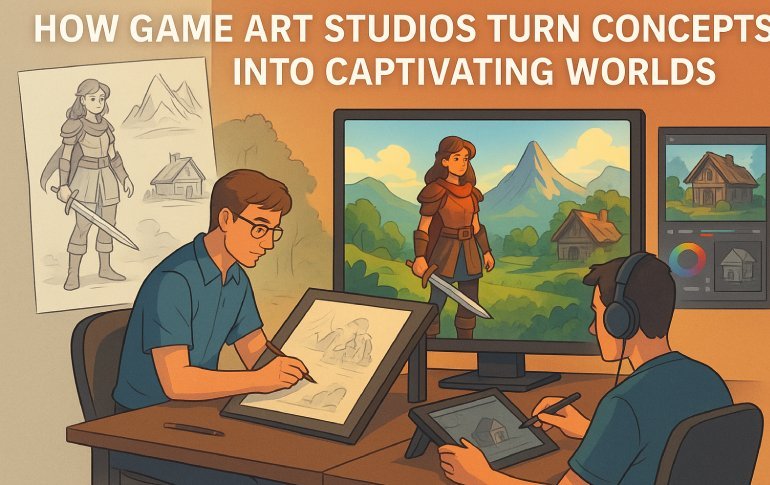other

July 11,2025 • 4 min read
How Game Art Studios Turn Concepts into Captivating Worlds

In today’s competitive gaming industry, it’s not just gameplay that draws players in—it’s the world they enter. Behind every visually stunning environment, every lifelike character, and every immersive interface, there’s a dedicated Game Art Studio turning ideas into interactive masterpieces.
But how exactly does that transformation happen?
Let’s break down the creative process that game art studios follow to turn raw concepts into compelling digital worlds.
1. Understanding the Vision
The process begins with understanding the game’s core concept. Game art studios work closely with game developers, narrative designers, and stakeholders to align the artistic direction with the game’s theme, genre, and emotional tone.
-
Is it a sci-fi thriller or a whimsical fantasy?
-
Who is the target audience?
-
What mood or visual identity should the game carry?
These answers set the stage for the entire creative process.
2. Concept Art Creation
Once the vision is locked, concept artists get to work. This phase is about visual exploration.
-
Characters are sketched with different personalities, clothing, and silhouettes.
-
Environments are drafted with mood boards and lighting ideas.
-
Weapons, vehicles, props, and UI elements are illustrated to match the narrative tone.
This is the sandbox phase—where ideas are refined until everyone sees the same world in their minds.
3. 3D Modeling and Sculpting
Once concepts are approved, they move into production. This is where 2D sketches turn into 3D assets.
-
Character artists sculpt lifelike or stylized figures using tools like ZBrush or Blender.
-
Environment artists model landscapes, buildings, and interiors.
-
Prop artists focus on the finer details—like crates, weapons, or magical artifacts.
The assets are optimized for performance without sacrificing detail.
4. Texturing and Materials
Now it’s time to bring those models to life. Game art studios apply textures and materials to give surfaces the look and feel of reality—or something beyond it.
-
Skin might have subtle pores.
-
A sword could gleam with scratches from past battles.
-
Alien terrain might glow under bioluminescent moss.
Tools like Substance Painter or Photoshop are often used here.
5. Rigging and Animation
For characters to move, they need a digital skeleton—a process called rigging.
Animators then breathe life into them:
-
Running, jumping, fighting, emoting.
-
Facial expressions for cutscenes or in-game dialogue.
-
Environmental animations like moving foliage or dynamic weather.
Animation is where static assets become active participants in the world.
6. Integration with Game Engines
With all assets ready, the studio integrates them into the game engine (like Unity or Unreal Engine). Here’s where the interactive world begins to take shape.
-
Level design starts to feel alive.
-
Lighting and shaders are applied.
-
Artists optimize for real-time rendering and cross-platform compatibility.
This phase ensures everything looks as intended while performing smoothly.
7. Iteration and Polish
Game art is never truly “done” after a single pass.
Studios go through rounds of testing, feedback, and polish to refine visual elements:
-
Adjusting color palettes
-
Improving performance
-
Enhancing visual storytelling cues
Only after these refinements does the art hit its final form.
Why Game Art Studios Matter
Partnering with a skilled Game Art Studio isn’t just about aesthetics—it’s about player immersion. These studios:
-
Translate abstract ideas into visual languages.
-
Understand how design affects gameplay and emotion.
-
Deliver optimized assets that balance beauty with performance.
In essence, they are world-builders, giving players spaces they can lose themselves in.
Final Thoughts
Creating a game world is an enormous task—but with the right art studio, that vision becomes a vivid, playable reality. From concept sketches to fully interactive 3D spaces, game art studios are the creative force that transforms imagination into digital experiences players never forget.
If you’re building a game and want it to stand out visually, investing in a professional game art studio isn’t a luxury—it’s a necessity.
Robert Wilson Details
User Profile
- Full name
- Robert Wilson
- Email address
- robert.wilson9893@gmail.com
- Join Date
- 2025-06-25
- State
- City
- Pincode
- Address
- Follow us on Facebook
- Follow us on Twitter
- Website Name
- https://www.cognihab.com/guided-vr-meditation-solution.php
- Bio
- Robert Wilson is a passionate expert in Augmented Reality (AR), Virtual Reality (VR), and Mixed Reality (MR).